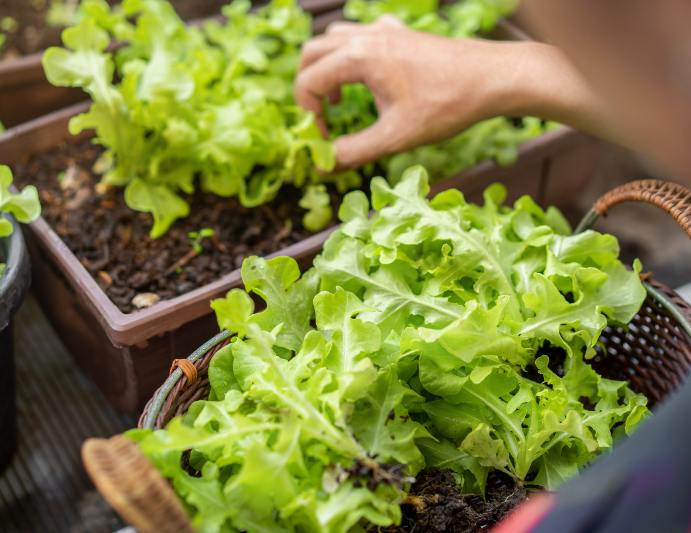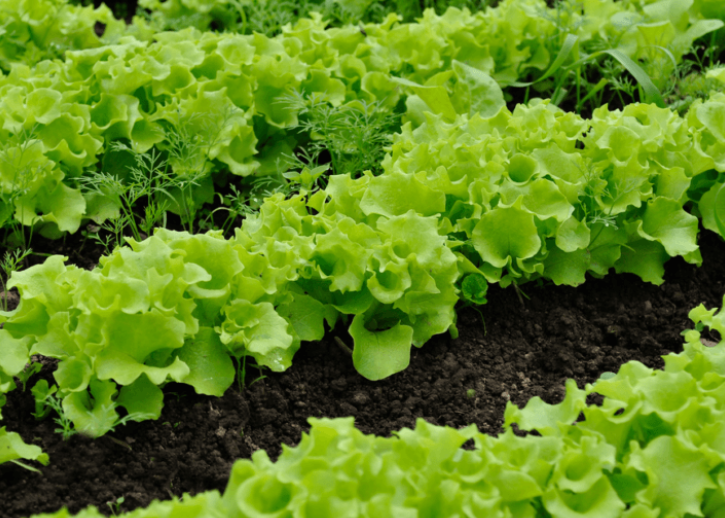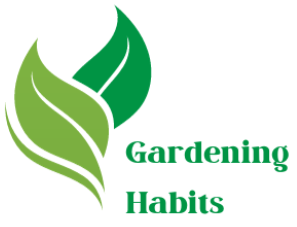How Many Lettuce Plants per Person?

Regardless of the type of lettuce you grow, spacing is everything. Planning your yields per person for the season ahead is tricky, as lettuces grow very different from one another, and some are useful both as cut-and-come-again crops as well as fully formed ball lettuces.
To try to get to grips with this big wide world of lettuce growing. How many lettuce plants per person? I’ve pulled together a comprehensive guide to growing lettuce for beginners with a focus on yields, and how many lettuce seeds to plant per person.
The best types of lettuce to grow at home
The title ‘lettuce’ is actually pretty hard to define, essentially referring to any ball-forming salad crop, but more often than not, true lettuces are best picked regularly through the season, and then left to develop.
That means that lettuce crops can be both light and leafy, or sturdy and crispy, depending on when you pick them, and how you grow them.
We grow dozens of lettuces here, from leafy salads to true lettuces, some of which grow best in summer, and others cope perfectly well with greenhouse conditions in winter for more salads per person all year round.
The best (and easiest) lettuces to grow for longer harvest seasons have to be
- Butterhead lettuce
- Cos lettuce
- Radicchio
- Iceberg Lettuce
But we also grow tons of leaf salads to spice up our dinner plates and add interest to an otherwise dull crop. Consider growing spinach, rocket, and mustard greens along with your lettuces to ramp up flavors. Herbs, like basil, mint, and fennel tops work beautifully in salads too.
Understanding lettuce yields
Some lettuces, like the loosely structured butterhead, can be used as gorgeously fluffy salad leaves right through spring and into summer, but you’ll need to stop picking them in mid-summer (July for me) to give them time to form the full heads of lettuce we know and love.
Others, like cos lettuce and iceberg, should be left well alone until they start to develop into a tight ball. For those types grown outdoors, or in raised beds, the outer leaves can look pretty ropey by the time you come to harvest, so don’t be afraid to remove them as they develop.
Some grow right down the middle and can be harvested as a cut-and-come-again crop, or left to develop. Radicchio is a perfect example of this, with its tart, bitter, leaves, which can be used for a subtle zing from early autumn.
After that, leave them to form tight red spikes of leaf, which can be harvested in early winter, or left to develop in greenhouse conditions right through to early spring in most climates.
A combination of different types of lettuce, planted at different times of the year can ensure you have enough lettuce plants per person all year round.
How many lettuces to grow per person, per season
In the table below, I’ve listed the average weight of each fully formed lettuce as well as an indication of the sort of yields you can expect if growing them as cut-and-come-again crops. By taking that into account, in combination with the spacing guidance in the table, you should be able to plan your harvests from the time of sowing.
For example, an average butterhead lettuce will develop to about 8” across in good conditions. That means planting them 10-12” apart to provide airflow between the fully formed plants. You can use the plant as cut-and-come-again leaves from 3-4 weeks after planting, and then leave it to form into a ball. Each stage is advised below.
It’s hard to pick a firm favorite, and it’s worth noting that weight doesn’t necessarily relate to usefulness or nutrition. Radicchio might be smaller, but with more bite, more flavor, and more vitamins than the rest, you don’t need as much on your plate.
Follow my lead, and grow a mix of everything if you’re feeling adventurous. You won’t be disappointed.

How to grow lettuce for better yields
Lettuce grows best in slightly cooler climates and can bolt (flower too early) if it gets too warm. This is the case for nearly every lettuce crop, and their tendency to bolt can put many gardeners off. Follow our guide for how to plant, sow and care for your lettuce below so you know exactly what to do with each variety.
Read more about lettuce bolting for more detailed guidance.
Preparing soil and compost for lettuce planting
All lettuces grow best in well-drained, cool soil that is rich in nutrients. Raised beds can be enriched with compost or manure before planting, which will add a perfect balance of drainage, along with natural moisture retention levels to stop them from drying out and bolting.
Pots and containers can hold moisture at their base, so make sure any container has sufficient drainage holes so lettuce roots are never sat in water. Preferably, grow lettuce in raised beds, cover them with mesh netting to keep bugs away, and provide some shade from extreme summer heat.
Choosing the right location to sow lettuce
Lettuces need bright conditions, where they have good access to sunlight, but are not subjected to direct afternoon heat.
How many lettuce plants per person? If you have a west-facing, or east-facing raised bed, with shade from the southern midday sun, then that is ideal. If not, consider growing peas or beans on the south edge of the bed to shade lettuce plants in the early afternoon.
When to plant lettuce for longer harvests
Perhaps even more critical than where and how you plant your lettuce crops is when. Certain varieties thrive best during spring and summer while others perform best during fall harvest season. My personal favorite, Radicchio, even thrives during the driest of winter conditions while developing stronger flavors because of this.
When to sow lettuce indoors:
- Iceberg lettuce: sow indoors from January to September
- Cos lettuce: sow indoors from February to March
- Butterhead lettuce: sow indoors from March to September
- Radicchio: sow indoors all year round
- Romaine lettuce: sow indoors from April to May
- Lollo rosso: sow indoors all year round
- Oak leaf lettuce: sow indoors all year round
When to sow lettuce outdoors:
- Iceberg lettuce: sow outdoors from April-June
- Cos lettuce: sow outdoors from March to July
- Butterhead lettuce: sow outdoors from April to July
- Radicchio: sow outdoors from April to September
- Romaine lettuce: sow outdoors from July to August
- Lollo rosso: sow outdoors from April to September
- Oak leaf lettuce: sow outdoors from May to September
Where to plant lettuces for longer lasting yields
The dreaded hungry gap can be easily overcome with a combination of winter lettuces and spring greens. Potatoes planted in late summer or early fall can even be grown on through winter in a greenhouse if you’re happy with slightly smaller harvests.
In late fall, plant a few rows of radicchio, rockets, and mustard greens in your greenhouse, or in pots in a cold frame. They will continue providing you with fresh, nutritious leaf crops through to Christmas, and often beyond.
Conclusion
Attributes that will influence how many lettuce plants per person? For any individual, vary based on: A) how much lettuce you consume; B) available space and C) harvest frequency. Lettuce is a staple food and shouldn’t be overlooked when creating an effective self-sufficient garden, so take your time learning about varieties, yields and spacing options before investing time in growing it yourself. If done right, a harvest of lettuce could provide enough for everyone in the household and it will last much longer than most other vegetables.
Ciara Konhaus

I’m Ciara and I’m a gardener and agricultural educator in zone 6b. I’ve farmed and gardened all over the Appalachian mountains and love to empower people with the tools they need to start their own gardens.
